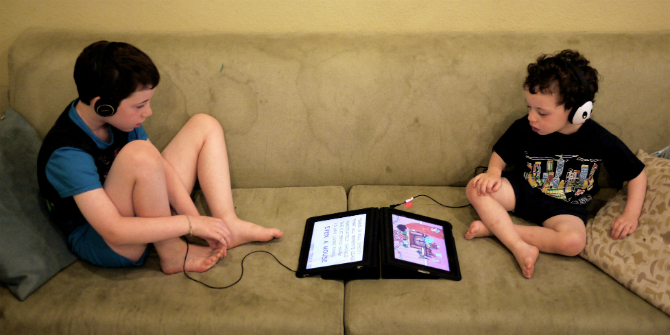There are overlaps between online victimisation and aggression – this is what the EU Kids Online study of 1,440 European children aged 9-16 showed. In this blog, Cristina Ponte, Maria João Leote de Carvalho and Susana Batista discuss the common traits and risks factors between the two pathways, as revealed in their recent article. High levels of perceived digital skills and high levels of emotional vulnerability are common to both online victimisation and aggression.
The term “online aggression” used in the EU Kids Online questionnaire designates hurtful interactions mediated by online technologies, whether or not repeated over time. According to children and adolescents, while aggressive communication encompasses “swear words”, “bad language”, “calling names”, and “cursing”, some stories of rude communication with friends are perceived as innocent jokes connected with the offline world. Thus, not all aggressive behaviour should be considered as bullying, and labelling interpersonal conflicts as bullying does not support teens to navigate their complex social relationships. Furthermore, everyday internet use may expand children’s interactions and opportunities for “drifting digitally” in and out of aggressive encounters, since identity flexibility is offered and pro-social influences seem less effective due to the relative absence of capable guardians.
Besides the relative lack of attention to the nuances of the interaction between victims and perpetrators and to the affordances of different platforms that facilitate this victimisation, the ySKILLS analysis of the antecedents and consequences of digital skills found that children who suffer from emotional problems and are digitally skilled are more likely to be exposed to problematic online content. This reinforces the idea that children who are more vulnerable offline– due to emotional problems, lack of family support and socioeconomic disadvantages– are also the ones more involved in online risks and harm.
With a focus on children who reported having engaged in aggressive acts online, we explored the following questions:
- Is there a relationship between internet access, uses and skills, on the one hand, and engagement in online aggression, on the other?
- What are the main psychological traits of the children who report online aggressive conducts?
- What kinds of social mediation, particularly from the family, are associated with online aggressors?
Online aggression: a brief overview of children’s profiles
A cluster analysis combining online practices and reported aggression identified three groups of children: 1) emerging users, emerging aggressors; 2) high users, high aggressors and 3) high users, occasional aggressors.
1) Emerging users, emerging aggressors
- More than four in ten are 9-11, followed by those aged 12-14.
- Slightly more boys than girls.
- The lowest ratios of access to devices, time of use, reported skills, online confidence, and sense of online safety.
- The highest rates of reporting more bothering online situations and requesting parents’ support.
- Around one-third report often experiencing unhappiness, lacking self-control, being accused of anti-social behaviour; they found it easier to be themselves and talk about different things online rather than face to face.
- One in five reported they often do exciting things even if those things are dangerous.
- Around one in five was cheated online, spent too much money on purchases and games, and experienced abuse of identity.
- More than half pointed out that parents neither encourage them to explore and learn things on the internet nor talk to them about what they do online.
2) High users, high aggressors
- Mainly aged 12+.
- Seven in ten are boys.
- They are by far the most engaged in almost all online communication and participatory practices, in which they expose themselves and take risks related to their privacy and safety.
- They report the most aggressive practices and the most intense victimisation, online and offline; they spend the most time on the internet, estimate the highest digital skills, present the highest emotionally and socially problematic behaviours.
- Around seven in ten often/always feel safe online.
- More than half reported doing exciting things even if they were dangerous, losing self-control, and experiencing unhappiness.
- Around one in three has been accused by others of lying and cheating.
- More than half report their parents hardly ever talk with them about what they do online.
3) High users, occasional aggressors
- Nine in ten are aged 12-16.
- Slightly more boys than girls.
- More than half are frequent internet users, accessing it for 3-6 hours a day and self-reporting high digital skills.
- Three in four are confident that they know what to do if someone acts online in a way they do not like.
- Around two-thirds feel safe online, almost half considered that online people are kind and helpful.
- Around a third report frequently losing self-control and doing ex-citing things.
- Antisocial behaviours are far less reported.
- The lowest rates of experiencing data misuse and problematic situations related to money, sending personal information (including photos or videos) or pretending to be a different kind of person.
- The highest proportion reporting perceiving their family as attentive, supportive, and safe.
Key findings
- Although the male predominance remains, the gender gap is not as wide as reported in studies on offline aggression.
- For almost half of the children, aggression goes hand in hand with victimisation.
- All groups share high levels of emotional deprivation, an exacerbated sense of online safety and trust in their own skills for dealing with problematic situations despite the victimisation experiences. Low self-control is the most consistent correlate of online aggression, aggravated by the ineffectiveness of parental online mediation.
- A frequent engagement in aggressive acts and high levels of problematic emotional characteristics, transgressive practices, recognition of others’ criticisms, and online performances related to communication and participation portrays high users, high aggressors as the “omnipotent masters of the digital”.
- The risk of the younger group falling into the frequent aggressive practices is relatively high, due to their psychological traits and signs of risky behavior, as well as to the lack of parental supervision and communication.
- The probability of online aggressive behaviour is higher if children do not benefit from adequate supervision and pro-social influences when using digital technologies.
Recommendations for policymakers
- The relationship between victimisation and aggression suggests the need of educational programmes and communication tools not only specifically targetting the critical years of early adolescence, but particularly the early school-age years.
- More effective prevention policies should address the persistent impact of ineffective parenting responses to children’s problematic behaviours. Parents and professionals working with children should benefit from learning digital skills and more effective relational strategies.
- Children and family services should improve their assessment tools, overcoming dichotomised categories of victim versus aggressor when dealing with children with problematic behaviours. As proven again in this analysis, “victim” and “aggressor” often refer to the same child.
Notes
This text was originally published on the ySKILLS blog and has been re-posted with permission.
This post represents the views of the authors and not the position of the Parenting for a Digital Future blog, nor of the London School of Economics and Political Science.








